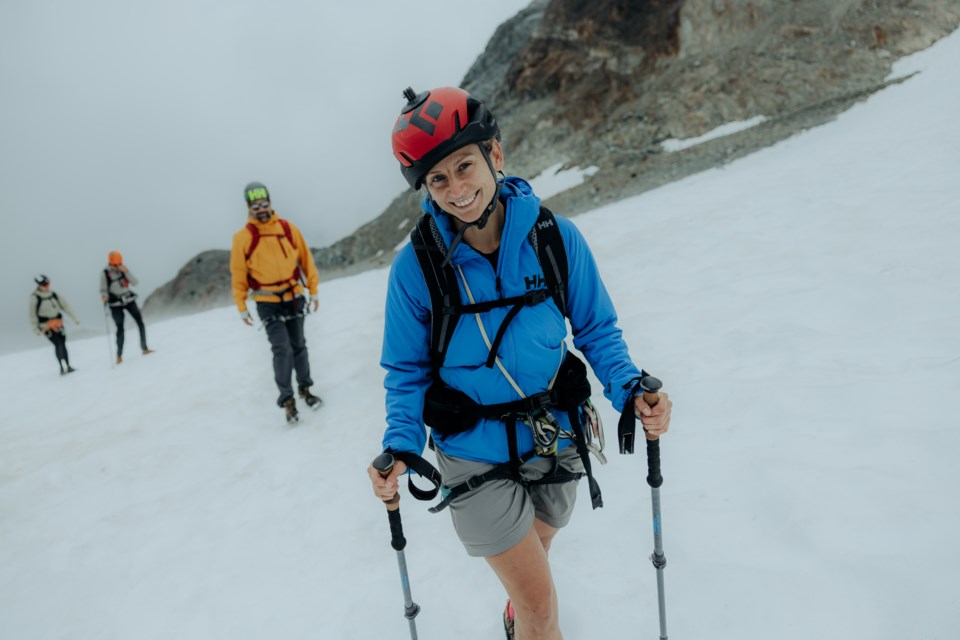I’ve never imagined hiring a mountain guide for an outdoor adventure, despite frequently spending time exploring the Coast Mountains. Most days I spend in the wilderness, I’m with seasoned climbers, kayakers, highliners and backcountry campers. With a such a merry band of dirtbags, who would need a guide?
But my opinion of working with a guide shifted recently. I had the chance to take on Sky Pilot as part of a press tour Helly Hansen was on. The trek was an example of the company’s current campaign called Open Mountain, where professional guides tell their stories, tips and tricks for outdoor adventures. Two guides took six guests on the 15 kilometre out and back trail. Aside from the guides, none of us had taken on the mountain.
The experience taught me more about my capabilities and the benefit of working with people who know the mountains like the back of their hands.
We met around 8:30 a.m. at the Sea to Sky Gondola parking lot, shaking hands and signing waivers, sorting through gear and getting to know each other a bit better.
After taking the tram, we began walking Sky Pilot Valley Trail. We travelled through the wooded path, which weaved its way across creeks on a steady incline before approaching an alpine meadow and Stadium Glacier. So far, it seemed reasonable for a person in good health. But from everything I’d read about Sky Pilot, from the moment we approached the glacier, it was technical, challenging terrain. It wasn’t something I was prepared to do without having folks on hand that had already summitted. I just never assumed it would be guides.
For most hikes or scrambles I’ve done, we didn’t know the exact route and there was a level of uncertainty inherent in our journey. As an anxious person, uncertainty can exacerbate feelings of panic or stress. It’s not so bad that I avoid uncertainty, but it leads to an underlying discomfort.
Also, I’m a small. Like, under 5 feet small. My stature means keeping up with long legs isn’t always a breeze.
Then, there’s my gender. As a woman, I’m socialized to avoid risk and there are underlying societal beliefs about capabilities that I’ve internalized.
Yet when I went on a guided scramble, the uncertainty, my size or my gender weren’t factors that were on my mind. I felt comfortable and safe knowing I could trust our leaders; the pace was appropriate for everyone on the trip, and by the end, I learned I wasn’t giving myself enough credit for by abilities in outdoor spaces.
We used ropes and harnesses traversing the glacier, the Pink Slab scramble and the chimneys. On the route, I thought about other scrambles I’ve done without the safety of being tied into an anchor and I suddenly realized I could come back to Sky Pilot and feel comfortable to lead others on the journey.
This was a 360 from what I thought I’d be able to achieve on Sky Pilot.
Yet that realization happened because the comfortable pace and encouragement I received from our guide, J.F. Plouffe.
Plouffe has guided for 25 years, and he works with Coast Mountain Guides. I spoke with him about the trip after and he smartly explained another benefit of paying for a guided trip.
“You have lots of friends that are really good at making dinner, and you go there and it's super good. But if they burn the dinner, you end up ordering pizza most of the time. The nice fish that you were planning – it's not happening. Well, you go to the restaurant, and they burn your fish, you're probably going to have another one.”
The same is true for a guiding experience – you get what you pay for and expected of the excursion. They know recent conditions, extra lines to hit, come with gear to fix yours if it breaks and have fantastic attitudes.
It’s also a pretty cool job. Plouffe said he gets to help people achieve bucket list items and it’s an honour to take people into the backcountry.
If I had the means, I’d likely hire guides like him for many cool trips. But, as a journalist, that’s unlikely. So, how does someone like me or you, dear reader, approach exploration without hiring a guide?
Plouffe suggested anyone who wants to get outside find a mentor who can show them the way, take courses and to start with something achievable. By taking small steps, we can eventually achieve greater and greater objectives.
“It’s the crescendo of a lot of different experiences. And the risk will always be the same, even if you have more experience,” Plouffe said.
An avalanche can happen regardless of whether you’re a professional or not. But with effective planning, from the route, gear and food ahead of time, to understanding the skill level and capability of the group you go out with, you can mitigate some risks inherent in outdoor exploration.
Thanks, J.F.




